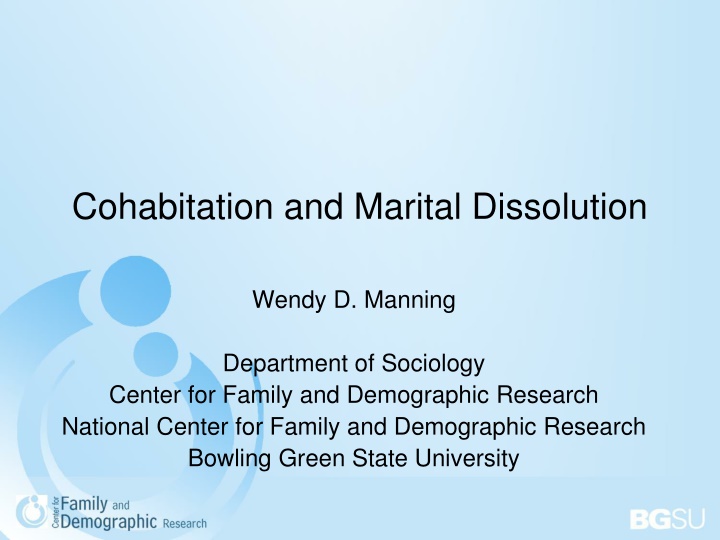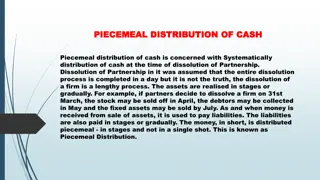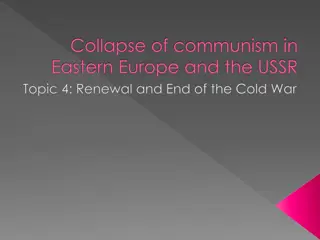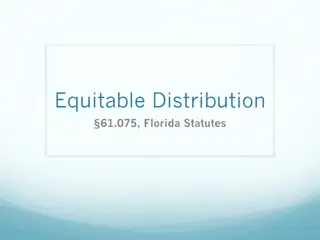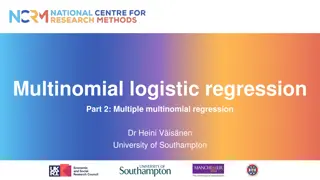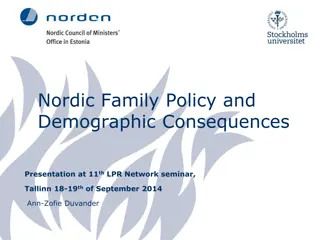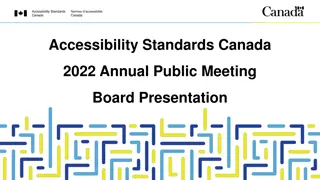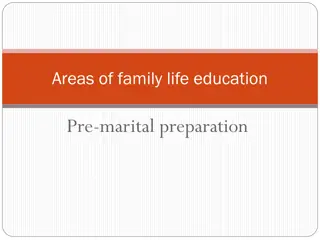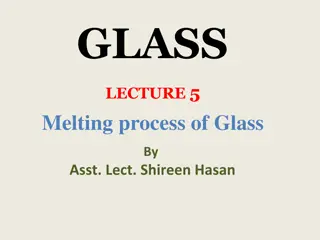Cohabitation and Marital Dissolution Trends in Canada and the US
This study by Wendy D. Manning from Bowling Green State University analyzes trends in cohabitation and marital dissolution in Canada and the US, presenting data on marriage rates, age at first marriage, cohabitation percentages, divorce rates, and household dynamics. The findings showcase shifting patterns in relationship structures and their impact on marriage stability over the years.
Download Presentation

Please find below an Image/Link to download the presentation.
The content on the website is provided AS IS for your information and personal use only. It may not be sold, licensed, or shared on other websites without obtaining consent from the author.If you encounter any issues during the download, it is possible that the publisher has removed the file from their server.
You are allowed to download the files provided on this website for personal or commercial use, subject to the condition that they are used lawfully. All files are the property of their respective owners.
The content on the website is provided AS IS for your information and personal use only. It may not be sold, licensed, or shared on other websites without obtaining consent from the author.
E N D
Presentation Transcript
Cohabitation and Marital Dissolution Wendy D. Manning Department of Sociology Center for Family and Demographic Research National Center for Family and Demographic Research Bowling Green State University
Outline Trends in Canada and US Studies of Cohabitation and Marital Dissolution Qualitative Findings Quantitative Results Discussion Collaborators: Jessica Cohen, Pamela Smock
Marriage Crude Marriage Rate Women US 7.4 Canada 4.4 Adjusted Rate per 1,000 unmarried (15+) Women US 32.9 Canada 22.2 Proportion Population Married (20+) Women US 52.9%% Canada 39.3%
Age at First Marriage, 1950-2010 36 34 32 30 28 26 24 22 20 18 16 1950 Canadian Men 1960 1970 Canadian Women 1980 1990 US Men 2000 2010 US Women Data from Statistics Canada and the U.S. Census
Cohabitation Percent population cohabiting (20+) US 5.5% Canada 8.9% 1970-79 20% of Canadian women married with cohabitation. 2000-2006 27% of Canadian women married with cohabitation. (France-Pascale M nard McGill Sociological Review, Vol. 2, April 2011 ) 1965-74 11% of US women married with cohabitation. 2000-2008 67% of US women married with cohabitation. (NCFMR - Manning, 2011)
Couple Households US Canada 18% 11% Cohab Married 82% 89% Data from Statistics Canada and the U.S. Census
Couples within Canada 2000-2006 Quebec ROC Cohab Married Cohab Married
Divorce Crude Divorce Rate (per 1,000 Population): 2.2 2005 Canada 3.8 2010 US Divorce Rate per 1,000 Married women 15+ 9.2 Canada US 16.4 Percent population divorced: 5.1% 2007 Canada 8.7% US 2010 Marriage Cohort 2008 Canada ~41% 2010 US~50%
U.S. Patterns Cohabitation Divorce Testing Ground
Cohabitation Trends 7529 8,000 7,000 Number in 1,000 s 6,000 5,000 4,000 2858 3,000 2,000 1,000 0
Cohabitation Trends Increase in cohabitation Percent of Women Ages 35-39 Who Ever Cohabited, U.S 70 63 60 50 61 Percent 40 48 30 20 30 10 0 1988 1995 2002 2006-2008 Year
Cohabitation Trends Majority of Newlyweds Cohabit Percent of First Marriages Preceded by Cohabitation by Marriage Cohort 80 70 60 65 65 50 56 40 46 41 30 32 20 10 11 0 1965-74 1975-79 1980-84 1985-89 1990-94 1995- 2002 2002- 2008
Median Age at First Marriage, Cohabitation, and Union, Women, 1984-2010 30.0 28.0 26.0 25.9 Age 1st Marriage Age 1st Cohab Age 1st Union 24.9 24.0 22.7 23.0 22.1 22.9 21.7 21.2 22.0 21.0 22.0 22.0 20.0 20.7 18.0 16.0 1984-1988 1991-1995 1998-2002 2006-2010
Cohabitation Paradox Marital Search Perspective Cohabitation weed out poor matches NSFH -- Couples can be sure they are compatible before marriage 51% and 56% of young men and women endorsing it as important. (Bumpass, Sweet, and Cherlin 1991)
Cohabitation and Marital Dissolution Positive association between cohabitation and marital dissolution Newcomb and Bentler (1980) Newcomb (1986) Bennet, Blanc and Bloom (1988) -- Sweden Teachman and Polonko (1990) DeMaris and Rao (1992) Schoen (1992) DeMaris and McDonald (1993) Lillard, Brien, and Waite (1995) Woods and Emery (2002) Teachman (2002) Teachman (2003) Kamp Dush, Cohen and Amato (2003) Phillips and Sweeney (2005) Brown, Sanchez, Nock, and Wright (2006) Stanley,Rhoades, Amato, Markman, and Johnson (2010) Rheinhold (2010) Jose, O Leary, and Moyer (2010) - Meta-analysis
Qualitative Data Views of Cohabitation Divorce-proof marriages Learn more about partner Practice marital roles lease, test drive
Cohabitation & Marriage in America 115 semistructured interviews: young adults who have ever cohabited 60 couples: cohabiting, married, or dating 18 focus groups 126 young adults P.I. s: Wendy Manning and Pamela Smock NIH: R03HD039835 and R01HD040910
Cohabiting Couple: Test Drive Joy: I kinda have the theory of, you know, test drive {LAUGH}. Test drive the car before you buy it. You know? Just kinda see, you know, because you could love each other but not be able to live with each other. Like if he s a slob and I m very clean, I would have a big problem with that. Bill: [Cohabitation]It s good, but it s bad. It s good because, umm, it will, you get to know the person and their habits before you get married. So that way, you won t have to get divorced. Or, some of the problems will come up before so you can work them all out before you get married.
Cohabiting Couple: Edge Lee: I think living together gives you that edge on people who don t live together before marriage, because you know what it is going to be like. You can make it last longer you know how to deal with problems of married life, at least that is what I think about it.
Married Couple: Roles Damion: Cohabitation prepared them for marriage becauseit showed who s gonna be the one paying the bills, who s gonna be the one doing that kind of stuff. That was a big thing. I guess, setting up roles. Like I would do the yard work, we both do the housework, she pays all the bills. Jen: Umm, it just helped me see what being married to him would be like. That he doesn t clean, he doesn t really cook, and that I had to be okay with that. Umm, how he spent his money or how he doesn t spend his money, or how he doesn t check the mail, how he doesn t pay the bills and that I have to do that.
Married Couple: Divorce Leah: At least you know how he s gonna be around you, instead of getting married and then living together for the first time. I think people would get more divorced because they don t know how that person acts. --------------------------------------------- Denise: I think maybe you ll have more of a chance of getting divorced if you don t live with somebody first, just cause then you don t know what to expect. Marriage is, harder than I thought it would be sometimes. Marriage is a lot of work, but anything is, I guess.
Married Couple: Divorce Maria. 1st interview: It s not a big deal to me anymore because I m already his wife you know. Nothing is going to change. 2nd interview: The biggest mistake was thinking that nothing was going to change, I didn t know my feelings about it would change I had commitment before, and I have commitment now, but now it s a wife commitment
Recent Reports Living together prior to marriage may help prevent divorce National (15-44: 2008-2010) 68% Men 58% Women Agree or Strongly Agree Young Adults (18-24: 2006) 60% Agree or Strongly Agree
Prior Studies Findings Complications Explanations
Cohabitation and Marital Dissolution Positive association between cohabitation and marital dissolution Newcomb and Bentler (1980) Newcomb (1986) Bennet, Blanc and Bloom (1988) -- Sweden Teachman and Polonko (1990) DeMaris and Rao (1992) Schoen (1992) DeMaris and McDonald (1993) Lillard, Brien, and Waite (1995) Woods and Emery (2002) Teachman (2002) Teachman (2003) Kamp Dush, Cohen and Amato (2003) Phillips and Sweeney (2005) Brown, Sanchez, Nock, and Wright (2006) Stanley,Rhoades, Amato, Markman, and Johnson (2010) Rheinhold (2010) Jose, O Leary, and Moyer (2010) - Meta-analysis
Cohabitation and Marital Dissolution Positive association between cohabitation and marital dissolution Selection Hypothesis Cohabitation Experience Hypothesis Inertia Hypothesis Diffusion Hypothesis
Cohabitation and Marital Dissolution Complications: Marriage Cohort Engagement Race/Ethnicity Sexual History Serial Cohabitation
Quantitative Analysis What is the relationship between cohabitation and marital dissolution? Engagement/Definite Plans for Marriage Marriage Cohort
Data 2006-2008 National Survey of Family Growth 7,356 women ages 15-44 6,139 men ages 15-44 Analytic sample 2,003 ever-married women since 1996 1,483 ever-married men since 1996 Dependent Variable Timing to divorce or separation of first marriage Focal Independent Variable Cohabitation experience w/ spouse
Data Race/Ethnicity and Nativity Status Number of premarital non-cohabiting sex partners Time at Marriage Children Prior Marriage Education (Interview date) Age at Marriage Background Family Characteristics Lived with biological parents Mother s education
Cohabitation Experience by Marriage Cohort Percent Women Men Pre 1996 No Cohab w/ Spouse Cohab Engaged Cohab Not Engaged N 57 25 18 53 25 23 (816) (1413) 1996 + No Cohab w/ Spouse Cohab Engaged Cohab Not Engaged N 38 35 27 39 33 28 (2003) (1483)
Premarital Cohabitation and Marriage Cohort: Women Hazard Ratio of Marital Dissolution < 1996 > 1996 Zero-Order Full Model Zero-Order Full Model Cohabitation 1.63** 1.43* 1.09 1.03 (No Cohabitation w/ Spouse) N 1413 1413 2003 2003 Note: Reference category in parentheses Full Model includes controls premarital birth, race/ethnicity, non-cohabitating sex partners, education, mother's education, childhood family structure, and age at marriage. +P<.10; *P<.05; **P< .01
Premarital Cohabitation and Marriage Cohort: Men Hazard Ratio of Marital Dissolution < 1996 > 1996 Zero-Order Full Model Zero-Order Full Model Cohabitation 1.86*** 1.70** 1.22 1.03 (No Cohabitation w/ Spouse) N 816 816 1483 1483 Note: Reference category in parentheses Full Model includes controls premarital birth, race/ethnicity, education, mother's education, childhood family structure, and age at marriage. +P< .10; *P<.05; **P< .01
Premarital Cohabitation and Marital Dissolution (WOMEN) Hazard Ratio of Marital Dissolution WOMEN Zero-Order Full Model Cohabitation Engagement Status (No Cohabitation w/ Spouse) Cohabitation & Engaged 0.75+ 0.57* Cohabitation & Not Engaged 1.40* 1.07 N 2003 +P< .10; *P<.05; **P< .01
Premarital Cohabitation, Engagement Status & Premarital Birth ( Women > 1996 Marriage Cohort) Hazard Ratio of Marital Dissolution Premarital Birth Zero 0.36* 0.81 No Premarital Birth Zero 0.97 1.30 Full 0 .37* 0.80 Full 0.80 1.26 Cohabitation & Engaged Cohabitation & Not Engaged (No Premarital Cohabitation) N 616 1387 Note: Reference category in parentheses Full model includes controls for non-cohabitating sex partners, education, mother's education, childhood family structure, and age at marriage. + p < .10; *P< .05; **P<.01; ***P< .001
Premarital Cohabitation and Marital Dissolution (MEN) Hazard Ratio of Marital Dissolution MEN Zero-Order Full Model Cohabitation Engagement Status (No) Cohabitation & Engaged 1.22 0.99 Cohabitation & Not Engaged 1.22 0.98 N 1483 +P< .10; *P<.05; **P< .01
Premarital Cohabitation and Marital Dissolution (WOMEN & MEN) Hazard Ratio of Marital Dissolution Women & Men Full Model w/ Interaction Zero- Order Full Model Cohabitation Engagement Status (No) 0.78 1.00 Cohabitation & Engaged 0.97 1.34* 1.06 1.00 Cohabitation & Not Engaged 1.02 0.95 1.07 Female Interactions Female x Cohabitation & Engaged 0.61+ Female x Cohabitation & Not Engaged 1.11 N 3486 +P< .10; *P<.05; **P< .01
Discussion It seems clear from the data that the impact of premarital cohabitation on a subsequent marriage is not a simple or direct relationship, but rather is multifaceted. - Newcomb and Bentler (1980, pg. 23)
Marriage Cohort Earlier marriage cohort Cohabitation is tied to greater instability regardless of engagement status Later marriage cohort Cohabitation is NOT tied to heightened marital dissolution Diffusion Perspective
Commitment at the start of cohabitation Engagement/definite marriage plans Half of adults who cohabited prior to a recent marriage made a commitment to marriage when they started living together Engagement status depends on premarital fertility No Births No cohabitation effect Births Engaged protective effect
Subgroup differentials: one size does not fit all Reframe: Relationship experiences: premarital divorce Variation among respondents who never cohabit Challenge our understanding of cohabitation and marriage dissolution Meaning of cohabitation and its role in marriage process
Thank you! Check out updates: National Center for Family and Marriage Research http://ncfmr.bgsu.edu/ Comments & Queries: wmannin@bgsu.edu
